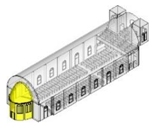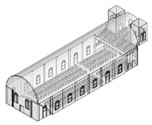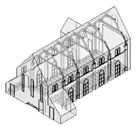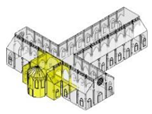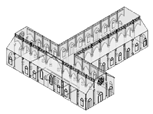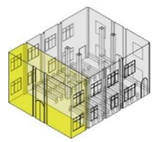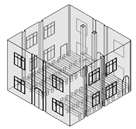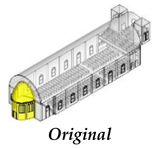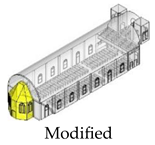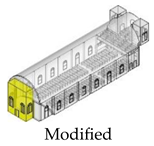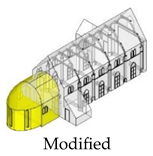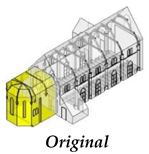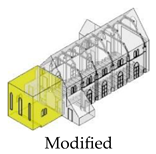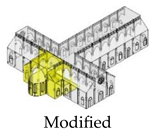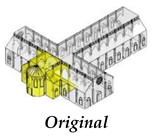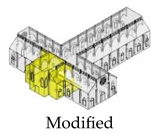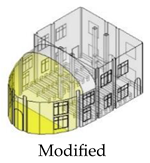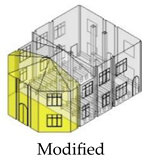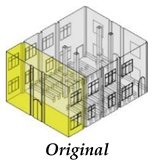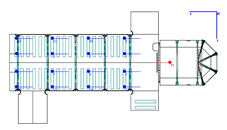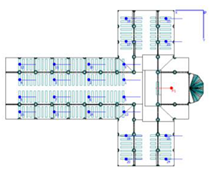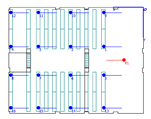Abstract
Two significant spaces define the soundscape of worship in a church: chancel and nave. The chancel is a space with the primary function of a sound source, where the preachers and choir are often seated during church services. Church design and layout have changed throughout history based on the functional needs of its target congregation. Some modern churches have omitted the chancel to fit contemporary design aesthetics. The main aim of this study is to investigate the relationship between the chancel and the acoustics performance of a church. Four churches with varying geometries of circular, polygonal, and rectangular chancels were selected for this study. Two simulations of varying chancel characteristics of chancel availability and chancel geometry were conducted. The recorded speech intelligibility index (STI) and reverberation time (RT) results indicate that chancel availability and geometry significantly affect churches’ acoustic performance. The simulation of the chancel availability mainly affected speech intelligibility, where the models with chancels recorded a higher STI than the models without chancels. In terms of chancel geometry, the results of the STI of the circular chancels were more encouraging than the polygonal and rectangular chancels.
1. Introduction
Gary Siebein [1] described the soundscape of worship as “based upon the presence of a cosmos, God or higher power worthy of worship with whom people feel a need to communicate in a variety of ways” (p. 5). One way in which people communicate in a church is through spoken words, be it through singing, chanting, reciting, or preaching. In the discussion of the soundscape of worship, each worship member has their own designated location in the worship space [1]. In church architecture, two significant spaces define the soundscape of worship: chancel and nave. The chancel is the space around the altar, located at the east end (front part) of a traditional church building. In terms of functionality, the chancel is the area where the altar is located and where the pastors and choir are often seated, while the congregation is usually seated in the nave [2,3]. Based on this spatial description, the differences between the chancel and nave can be distinguished in that the nave is intended as an area for sound receivers, while the chancel acts as the sound source.
Acoustics in churches play a significant role in the Christian worship service, as most of the service consists of singing and preaching. In early Rome, Christian worship meetings were held in secret and, thus, worshippers occupied underground galleries of ancient mines. These catacombs are spaces made of stones, which essentially made them caves. The nature of caves dictates that the acoustics have a very long reverberation time [4]. The long reverberation had an impact on how sacred texts were perceived. Acoustic environments that create reverberant and fragmented accentuation can magnify the intensity of the emotional impact and create a sensory experience of divine spiritual attachment, which might have a decisive impact on the later development of church liturgy [4,5,6].
During the Middle Ages, namely, during the Renaissance, monumental cathedrals of the Roman Catholics had acoustical environments with high reverberation for musical liturgy and chanting. Early Christian service encouraged choral singing as part of the main liturgy due to the language barrier that persisted at the time, when the people did not know Latin. The only way to engage congregations spiritually was through music and singing. It was only later when the Vatican Council’s emphasis on the significance of understanding the sermons that national languages were introduced in catholic churches [3,5,7,8,9]. Eastern Orthodox churches are dominated by one primary form of sound transmission, which is singing, as the liturgy of most churches consists of singing for most of the service. The only spoken part of the service is when the pastor is preaching to the congregation [10]. Therefore, unlike medieval cathedrals, the early churches and synagogues required less reverberant spaces, as their worship services mainly focused on sermons and scriptural readings [7].
In early 1517, the Protestant Reformation began, dismantling the institutional unity of the Roman Catholic Church in Western Europe and pioneering a new branch of Christianity. Since the beginning of this era, speech intelligibility has become a significant acoustical parameter in church services compared to previous medieval cathedrals [11].
Modern worship spaces in churches have several functions based on the church’s liturgical style. For example, the cathedrals are suitable for the organ’s musical sounds and chants due to the fact of their high reverberation. At the same time, these cathedrals also need to fulfil the role of providing sermons and speeches from church leaders that require a greater need for speech intelligibility. On the other hand, the evangelical liturgical style has a large volume, like cathedrals. However, the worship service only plays contemporary music, usually accompanied by electrical organs and keyboards [11].
Traditionally, a church can be categorized as a highly reverberant space, not only due to the materials chosen to build the space but also because the spaces were meant for a congregation of a large number of people, hence the vast size of the space [9]. Due to the various acoustic needs of services, churches are acoustically challenged in that they need to strike a balance between clear speech intelligibility during sermons and musical singing during worship, as the reverberation time required for both situations have a difference of one-half of the value. Ideally, one should not be sacrificed for the other [8,12,13,14].
Accounts regarding the acoustical qualities of churches were first written by Sir Christopher Wren (1632–1723), a British architect who was famous for the reconstruction of churches after the Great Fire in London in 1666 [15]. Church acoustic studies have been growing ever since, with more studies being conducted on the effects of reverberation time and other acoustic descriptors, such as definition (D50), center time (Ts), musical clarity (C80) and intelligibility, physical properties of materials, and even room designs [4,8,16,17,18].
The geometrical elements of a church significantly impact its acoustics performance. Alvarez-Morales and Martellotta [19] discussed the geometrical acoustics of six historic Catholic churches in Italy and Spain. The study describes the geometrical properties present in these churches and how they affect the acoustics performance of each church. The geometrical elements discussed include the layout plan (rectangular plan, Basilican plan, Latin cross plan, and Greek cross plan) and the arch style of the roofs (Romanesque, Gothic, Renaissance, and Baroque) [19]. A typical church shape is the cross shape, consisting of a central rectangular hall with additional side rectangles and another rectangular space in the front for the altar, sanctuary, or chancel [20].
For optimum acoustical performance in a church, the fundamental room geometry must be considered during the preliminary design stage of the church. Some geometrical shapes carry more benefits than others, especially in the projection of early speech sound, which is crucial for optimum speech intelligibility. On the other hand, some room shapes can cause serious acoustical hindrances, such as standing waves, flutter echo, wound focusing, and intensive late reflections that are greater than 100 ms. Concave shapes that concentrate reflected sound should be avoided, especially if not appropriately treated with sound-diffusing materials [21,22].
In addition, long, flat parallel walls can result in undesirable flutter echo that drastically lowers speech intelligibility. Spatial separation, as seen in older churches, such as alcoves and archways, can lower the effectiveness of the projection of early speech sound, thus leading to weaker speech intelligibility [7]. Furthermore, wide fan shapes and semicircular plans usually will not project strong early lateral reflections, because the perimeter walls will be located too far apart unless overhead sound reflectors are installed to help solve the lack of lateral sound reflected from the walls. However, the “reverse” fan shape (i.e., a room that tappers towards the end) can provide music’s most excellent lateral reflections and spatial impression [23,24].
These geometrical considerations should be taken into account in designing the floor plan, the section of the room, and a room’s geometry in three dimensions. Henceforth, the ratios of the room’s length to its width and the ratio of the room’s height to its width are significant design considerations that need to be considered [7].
The main aim of this study was to investigate the impact of the chancel on churches’ acoustics performance using computer modeling and simulation analysis. The study focused on the spatial distribution patterns of speech intelligibility (STI) and reverberation time (RT) in the absence of artificial sound reinforcement systems. The room characteristics concerning the chancel experimented on in this study were (i) chancel availability and (ii) chancel geometry.
2. Methodology
The selection of churches representing Malaysia’s traditional churches was based on their differing chancel shapes. Four churches in Kuala Lumpur and Selangor, with three distinct chancel shapes of circular, polygonal, and rectangular, were selected. Traditional churches from the 1890s to 1930s were selected for the study, as chancels were only found in traditional churches. This is because chancels have become less defined in modern church designs [25]. The measured drawings of the four churches were obtained from student works in the University of Malaya’s Built Environment Library. The churches selected have a seating capacity of fewer than 1000 seats, as this is generally acceptable for churches that utilize only natural sound sources [26]. The capacity and physical measurements of the church are summarized in Table 1 and Table 2.

Table 1.
Main physical characteristics of the churches in this study.

Table 2.
Main dimensions of the churches in this study.
2.1. Chancel Availability vs. Acoustical Performance
The first objective of this study was to identify and analyze the acoustical performance of traditional churches based on the availability of a chancel. Thus, in Simulation 1, the four churches were modeled with and without their chancels, as illustrated in Table 3. In contrast, the property of the churches’ naves remained constant, including their volume, seating capacity, and assigned material.

Table 3.
The four churches and their modified chancels’ availability (Simulation 1).
2.2. Chancel Geometry vs. Acoustical Performance
The study’s second objective was to identify the chancel geometry’s impact on the church’s acoustical performance. Simulation 2 consisted of simulations of each church with its original chancel shapes and simulations of each church with modified chancel shapes of two other geometries of either circular, polygonal, or rectangular chancel shapes, as illustrated in Table 4. As the simulation aimed to see the effect of different chancel geometries, it was ensured that the chancel shapes were the only variable of the models. Hence, even though the chancel geometry was modified, the volume and finishing materials of the chancel remained almost the same.

Table 4.
The four churches with their original and modified chancel shapes (Simulation 2).
2.3. Simulation Procedure
The plans and sections of the four selected churches were collected. The naves and chancels of these churches were then modeled into three-dimensional drawings using Google SketchUp 2016. This software was chosen because of its compatibility with ODEON Room Acoustic Software 13.02 Industrial requirements, which was the selected acoustic software for this study. ODEON recommended that the surfaces of the models used in the software be constructed in large dimensions of approximately 0.34 m, which was deemed to be higher than one wavelength at the midfrequency range [27,28]. Hence, architectural details such as ornaments, cornices, and framings were excluded during the 3D modeling process, because such detail does not create any prominent early reflections to the receivers and the results of the simulations [28,29,30]. However, based on a previous study on modeling simplification for acoustics simulation in ODEON [27], it was determined that some details pertaining to the typical components of churches, such as doors and windows, remained as is. The finalized models were then imported into ODEON. They were examined for “leakages” by conducting a water tightness test using 3D investigative rays, as recommended in ODEON [28]. This step ensured that the model was fully enclosed to produce simulations with accurate readings.
The sound sources for each church were positioned at the center of the chancels and raised 1.5 m above the floor level to mimic the average height of a standing person [26]. As the churches selected for this study are traditional churches built in the early 1900s to the 1990s, the study conducted the experiment by assuming the absence of a modern audio system, which explains the sound source type used in this study. The receivers were spread uniformly throughout the churches’ nave in rows from the front, middle, and rear at a height of 1.2 m. Table 5 shows the basic room setting information for the simulations. The positioning of the sound sources and receivers for each church is illustrated in Table 6. Since there are no acoustical data and detailed information on the acoustic properties of the materials in the measured drawing, the materials assigned were applied with the nearest absorption coefficient data that could represent the typical or plausible surfaces and materials of the churches, which were adapted from the software’s material library database. As this study focused on the effect of chancel availability and geometry, the same set of materials with similar acoustic absorption coefficients was applied to avoid random variables that could affect the simulation results. It should also be noted that all simulated models considered 100% occupancy as a constant variable representing the church’s full operation. This is reflected in the material selection for the seating. Table 7 shows the absorption coefficients of the materials applied in the simulated models.

Table 5.
Basic information of the simulation settings fixed in ODEON.

Table 6.
Location of the sound source and receivers (red: source; blue: receiver).

Table 7.
Sound absorption coefficient of the materials used in the simulated models.
It should be noted that the plans and sections of the existing traditional churches used in this study were obtained from an architectural library archive, which was the product of a measured drawing class, a compulsory subject in the architectural curriculum. The course aimed to produce related documents and learn about architectural elements, such as building plans, concepts, layouts, spatial organization, and architectural details, of Malaysia’s architectural heritage buildings. The study of acoustics was not included then; hence, the data only contained information on the design and technical measurements of the churches. Furthermore, the churches have undergone significant refurbishment work, which has diverted the construction and finishes from the original design. As the study’s primary purpose was to study and compare the chancel availability and forms in the early design of the churches, the need to compare the simulated acoustic data with the actual measured data was omitted. This should not affect the research’s primary purpose, which was experimenting with the geometrical designs of the churches. Nevertheless, the conditions of the models were regulated by applying materials that matched the churches’ plausible surface materials. Hence, the discrepancies and variables between the original and the modified models were limited to only the geometrical differences.
2.4. Acoustical Parameter
The acoustics parameters used to determine the acoustical performance of the selected churches in this study were the (i) speech transmission index (STI) [31] and (ii) reverberation time (RT).
Figure 1 shows that a good STI rating ranges from 0.6 to 0.75. Ermann [32] describes speech intelligibility as the ability to identify and distinguish the form and structure of the speech sound and to identify the sound of consonants and vowels clearly. A reference scale was proposed by Barnett [33], the Common Intelligibility Scale (CIS), based on a mathematical relation with STI (CIS = 1 + log (STI)).

Figure 1.
Speech Transmission Index (STI) rating and the Common Intelligibility Scale (CIS).
Doelle [34] recommended that the RT for traditional churches depends according to the respective church sizes. Since all churches selected in this study are Roman Catholic churches, the recommended RT is determined as follows: C1, P1, P2 is between 2.0 and 2.6 s, and R1 is 1.9 s.
3. Results and Discussion
3.1. Chancel Availability vs. Acoustical Performance
Figure 2 illustrates the speech intelligibility ratings of the four churches in the with- and without-chancel simulations. The effectiveness of the chancels is evident across the graphs, where the simulation with chancels showed more uniform and constant STI readings, even at receivers located farther away from the sound source. The without-chancels simulation showed stronger STI readings near the sound source. However, the steep graph line indicates a quick decrease in the STI as the distance increased. The with-chancel simulations have better STI ratings at longer distances from the sound source than the without-chancel simulations. Generally, all churches, regardless of the chancel availability, had “good” ratings in the STI of 0.6–0.75. This is because the presence of a chancel helps direct the early sound reflections from the source to the back of the room and enables a more uniform STI reading. Older churches tend to have chancels to assist in projecting sound from the preacher to the congregation to ensure the speech can be heard clearly throughout the church.
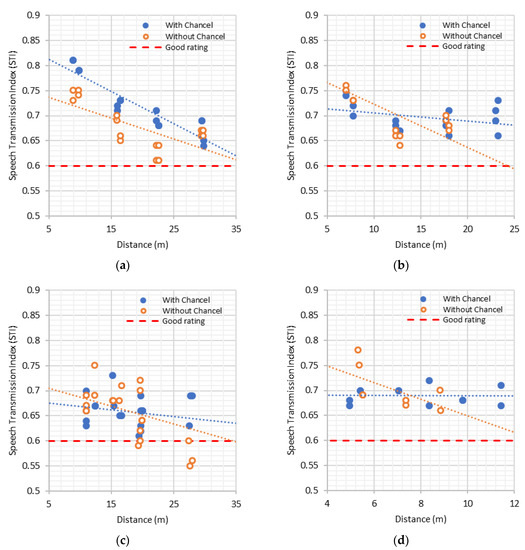
Figure 2.
Comparison of the average STI between the simulations with a chancel and without a chancel: (a) C1; (b) P1; (c) P2; (d) R1. (Blue and orange dotted lines are the trendlines for both with and without chancel data, respectively).
Figure 3a–d compare the reverberation time (RT) readings of the four churches in the simulations with and without chancels, respectively. The RT data for both simulations are presented in the midfrequency range of 250 Hz to 2000 Hz, which is within the normal human voice range. Through the simulations, it is evident that the chancel’s availability impacts the RT value in the church. However, the impact is not consistent in all churches. The simulation results for C1 and P1 show that the two churches obtained lower RTs without chancels. Meanwhile, the P2 results show a different trend, where the model without a chancel resulted in slightly higher RT levels. On the other hand, R1 shows no changes in the RT values for both models. It should be noted that none of the churches, with or without a chancel, attained the recommended RT of 2.0–2.6 s for the large churches (C1, P1, and P2) and 1.9 s for the medium churches (R1).

Figure 3.
Comparison of the average RT between the simulations with a chancel and without a chancel: (a) C1; (b) P1; (c) P2; (d) R1.
Comparing the simulated results between STI and RT for the four churches, it is evident that the RT levels were low, as they fell way below the recommended RT levels. As music needs a longer RT to be effective and stimulating, the RT should be on the higher side of the recommended range [31]. Therefore, it can be said that the four churches are more appropriate for preaching services rather than for singing or music.
3.2. Chancel Geometry vs. Acoustical Performance
Figure 4 shows the effectiveness of the circular, polygonal, and rectangular chancel shapes on the STI for the four churches. The circular chancels performed the best in terms of speech intelligibility in C1, P2, and R1. The concave walls and ceiling of the circular chancel help focus and direct sound reflections [31,35,36] towards the congregation seated at the nave or, in this case, the sound receivers, thus providing better STI readings compared to other geometries. Regardless, the polygonal chancel performed better in P1. The rectangular chancels consistently recorded the lowest STI readings across all churches compared to the circular and polygonal shape chancels. Regardless of the chancel geometry, all churches recorded exceptional STI readings above 0.6. C1, and R1 reached “excellent” STI ratings of 0.75 and above in some receiver points closer to the sound source.

Figure 4.
Comparison of the average STI among the various chancel shapes: (a) C1; (b) P1; (c) P2; (d) R1. (Blue, orange, and grey dotted lines are the trendlines for circular, polygonal, and rectangular church data, respectively).
The effectiveness of the different chancel shapes on the reverberation time (RT) for C1, P1, P2, and R1 are presented in Figure 5. Throughout the four churches, it is apparent that rectangular chancels resulted in the highest RT. On the other hand, circular chancels recorded the lowest RT, even in C1, which has a circular chancel as the original chancel shape. Circular and polygonal chancels have concave walls and ceilings, which cause too many early sound reflections [31,35,36]. This leads to energy loss as they reach the sound receivers and, thus, lose decibels faster, leading to a lower RT in circular and polygonal chancels than rectangular chancels. As per the RT results from Simulation 1, none of the churches achieved the recommended RT of 2.0–2.6 s for the large churches (C1, P1 & P2) and 1.9 s for the medium size churches (R1).
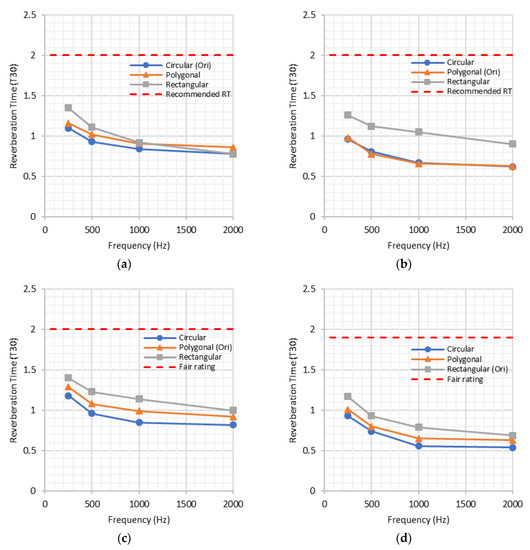
Figure 5.
Comparison of the average RT among various chancel shapes: (a) C1; (b) P1; (c) P2; (d) R1.
4. Conclusions
In the study of church acoustics, many layers and variables can significantly affect the acoustics performance. The variables of physical design alone can range from the geometrical shapes of the floor plans, room width and height, and the volumetric area to the selection of materials for the internal surfaces of the church. The presence of a congregation or, in technical terms, the room occupancy ratio is another determining factor of church acoustics performance. The presence of people could indirectly affect the acoustics of a church by increasing the sound absorption in the space, lowering the RT and, consequently, increasing speech intelligibility. Another crucial element that can significantly influence a church’s acoustics is the audio design. Whether or not a church uses a public address (PA) system or depends solely on the preacher’s voice power can influence the acoustic performance and the physical design of the church as well. However, the main objective of this study was to analyze the impact of chancel availability and geometrical form on the acoustical performance of traditional churches. Four traditional churches with distinct chancel features were categorized into three main geometrical categories: circular, polygonal, and rectangular. The general results showed that the chancel design could impact the performance of the acoustics, specifically the RT and speech intelligibility, a significant parameter in the study of church acoustics. Based on the results presented in this study, it can be concluded that the chancel can notably impact the acoustics performance of a church. Simulation 1, which studied the availability of a chancel, demonstrated how the presence of a chancel significantly influences speech intelligibility. The presence of a chancel assisted in making sure speech sounds were still comprehensible, even for the congregation at the back of the nave. On the other hand, the chancel availability presented little impact on the churches’ RT due to the inconsistent results from all four churches. Regarding the chancel shapes studied in Simulation 2, rectangular-shaped chancels recorded the highest RT compared to other chancel shapes. This might be due to the small amount of sound wave reflection that produces constructive waves, which could be better for reverberation. However, none of the churches with any chancel shapes achieved their respective recommended RT. Meanwhile, circular-shaped chancels fared well in the STI rating due to the short distance between the wall and the sound source, leading to more early reflections reaching the audience more quickly. Further onsite investigations with existing conditions and occupancy ratio experiments are being pursued intensively.
Author Contributions
Conceptualization, C.Y.S.-Q. and N.B.C.D.; methodology, C.Y.S.-Q. and N.B.C.D.; investigation, C.Y.S.-Q.; resources, C.Y.S.-Q., N.A.A.J. and N.B.C.D.; writing—original draft preparation, C.Y.S.-Q.; writing—review and editing, N.A.A.J., N.B.C.D., C.P., A.P. and W.A.; supervision, N.B.C.D.; project administration, N.B.C.D.; funding acquisition, N.B.C.D., C.P. and W.A. All authors have read and agreed to the published version of the manuscript.
Funding
This research was supported by the UM International Collaboration Grant, University of Malaya, grant number: ST038-2022.
Data Availability Statement
The data presented in this study are available upon request from the corresponding authors.
Acknowledgments
The authors would like to thank the Department of Architecture, University of Malaya, for providing measured drawings of churches used for the research in this paper.
Conflicts of Interest
The authors declare no conflict of interest.
References
- Sieben, G. The Soundscape of Worship. In Worship Space Acoustics: 3 Decades of Design; Bradley, D.T., Ryherd, E.E., Ronsse, L.M., Eds.; Springer: New York, NY, USA, 2016. [Google Scholar]
- Curl, J.S. A Dictionary of Architecture and Landscape Architecture; Oxford University Press: Oxford, UK; New York, NY, USA, 2006. [Google Scholar]
- Bradley, D.T.; Ryherd, E.E.; Ronsse, L.M. (Eds.) Worship Space Acoustics: 3 Decades of Design; Springer: New York, NY, USA, 2016. [Google Scholar]
- Girón, S.; Álvarez-Morales, L.; Zamarreño, T. Church acoustics: A state-of-the-art review after several decades of research. J. Sound Vib. 2017, 411, 378–408. [Google Scholar] [CrossRef]
- Cairoli, M. Identification of a new acoustic sound field trend in modern catholic churches. Appl. Acoust. 2020, 168, 107426. [Google Scholar] [CrossRef]
- Algargoosh, A.; Soleimani, B. The impact of the acoustic environments on the emotional experience of worship spaces. J. Acoust. Soc. Am. 2019, 146, 3022–3023. [Google Scholar] [CrossRef]
- Lee, S.J. Comparative Analysis of Speech Intelligibility in Church Acoustics Using Computer Modeling. Doctoral Dissertation, University of Florida, Gainesville, FL, USA, 2003. [Google Scholar]
- Fernández, M.; Recuero, M.; Cruz, D. Church Acoustics. In Proceedings of the Forum Acusticum (RBA-05-015), Seville, Spain, 16–20 July 2002. [Google Scholar]
- Iannace, G.; Berardi, U.; Rossi, F.D.; Mazza, S.; Trematerra, A.; Ciaburro, G. Acoustic enhancement of a modern church. Buildings 2019, 9, 83. [Google Scholar] [CrossRef]
- Kosała, K.; Małecki, P. Index assessment of the acoustics of Orthodox churches in Poland. Appl. Acoust. 2018, 130, 140–148. [Google Scholar] [CrossRef]
- Lubman, D.; Wetherill, E.A. Acoustics of Worship Spaces; American Institute of Physics for the Acoustical Society of America: College Park, MD, USA, 1985. [Google Scholar]
- Berry, R.; Kinzey, B.Y. Planning for sound in church worship. Archit. Forum 1954, 101, 164–166. [Google Scholar]
- Berardi, U. A double synthetic index to evaluate the acoustics of churches. Arch. Acoust. 2012, 37, 521–528. [Google Scholar] [CrossRef]
- Kosała, K.; Engel, Z.W. Assessing the acoustic properties of Roman Catholic churches: A new approach. Appl. Acoust. 2013, 74, 1144–1152. [Google Scholar] [CrossRef]
- Navarro, J.; Sendra, J.; Muñoz, S. The Western Latin church as a place for music and preaching: An acoustic assessment. Appl. Acoust. 2009, 70, 781–789. [Google Scholar] [CrossRef]
- Carvalho, A.P.; Morgado, A.E.; Henrique, L. Relationships between subjective and objective acoustical measures in churches. Build. Acoust. 1997, 4, 1–20. [Google Scholar] [CrossRef]
- Brezina, P. Measurement of intelligibility and clarity of the speech in romanesque churches. J. Cult. Herit. 2015, 16, 386–390. [Google Scholar] [CrossRef]
- Małecki, P.; Wiciak, J.; Nowak, D. Acoustics of Orthodox churches in Poland. Arch. Acoust. 2017, 42, 579–590. [Google Scholar] [CrossRef]
- Alvarez-Morales, L.; Martellotta, F. A geometrical acoustic simulation of the effect of occupancy and source position in historical churches. Appl. Acoust. 2015, 91, 47–58. [Google Scholar] [CrossRef]
- Petit, J.L. Remarks on Church Architecture; J. Burns: London, UK, 1841; Volume 2. [Google Scholar]
- Riedel, S.R. Acoustics in the Worship Space; Concordia Publishing House: St. Louis, MO, USA, 1986. [Google Scholar]
- Sukaj, S.; Bevilacqua, A.; Iannace, G.; Lombardi, I.; Parente, R.; Trematerra, A. Byzantine Churches in Albania: How Geometry and Architectural Composition Influence the Acoustics. Buildings 2022, 12, 280. [Google Scholar] [CrossRef]
- Din, N.B.C.; Lew, H.Y.; Razak, A.S.A. Relationship between room characteristics and speech intelligibility in contemporary churches in Malaysia. Int. J. Automot. Mech. Eng. 2016, 13, 3451–3461. [Google Scholar] [CrossRef]
- Lew, H.Y. Comparative Study of the Acoustic Performance in Churches by Using Computer Simulation. Master’s Dissertation, Department of Architecture, Faculty of Built Environment, University of Malaya, Kuala Lumpur, Malaysia, 2015. [Google Scholar]
- Poole, T. Chancel. In Catholic Encyclopaedia. Available online: http://www.newadvent.org/cathen/03572b.htm (accessed on 9 November 2022).
- Egan, M.D. Architectural Acoustics; McGraw-Hill: New York, NY, USA, 1988. [Google Scholar]
- Abd Jalil, N.A.; Din, N.B.C.; Keumala, N.; Razak, A.S. Effect of model simplification through manual reduction in number of surfaces on room acoustics simulation. J. Des. Built Environ. 2019, 19, 31–41. [Google Scholar] [CrossRef]
- Christensen, C.L.; Koutsouris, G. ODEON Room Acoustics Software-Version 12; Basic, Industrial, Auditorium and Combined Editions; ODEON: Kongens Lyngby, Denmark, 2013. [Google Scholar]
- Siltanen, S.; Lokki, T.; Savioja, L.; Lynge Christensen, C. Geometry reduction in room acoustics modeling. Acta Acust. United Acust. 2008, 94, 410–418. [Google Scholar] [CrossRef]
- Bradley, J.S.; Sato, H.; Picard, M. On the importance of early reflections for speech in rooms. J. Acoust. Soc. Am. 2003, 113, 3233–3244. [Google Scholar] [CrossRef] [PubMed]
- Steeneken, H.J.M.; Houtgast, T. A physical method for measuring speech-transmission quality. J. Acoust. Soc. Am. 1980, 67, 318–326. [Google Scholar] [CrossRef] [PubMed]
- Ermann, M. Architectural Acoustics Illustrated; John Wiley & Sons, Inc.: Hoboken, NJ, USA, 2015. [Google Scholar]
- Barnett, P.W. Overview of speech intelligibility. Proc.-Inst. Acoust. 1999, 21, 1–16. [Google Scholar]
- Doelle, L. Environmental Acoustics; McGraw-Hill, Inc.: New York, NY, USA, 1972. [Google Scholar]
- Kuttruff, H. Room Acoustics, 5th ed.; Spon Press: London, UK; New York, NY, USA, 2009. [Google Scholar]
- Barron, M. Auditorium Acoustics and Architectural Design, 2nd ed.; Spon Press: London, UK; New York, NY, USA, 2010. [Google Scholar]
Disclaimer/Publisher’s Note: The statements, opinions and data contained in all publications are solely those of the individual author(s) and contributor(s) and not of MDPI and/or the editor(s). MDPI and/or the editor(s) disclaim responsibility for any injury to people or property resulting from any ideas, methods, instructions or products referred to in the content. |
© 2023 by the authors. Licensee MDPI, Basel, Switzerland. This article is an open access article distributed under the terms and conditions of the Creative Commons Attribution (CC BY) license (https://creativecommons.org/licenses/by/4.0/).
